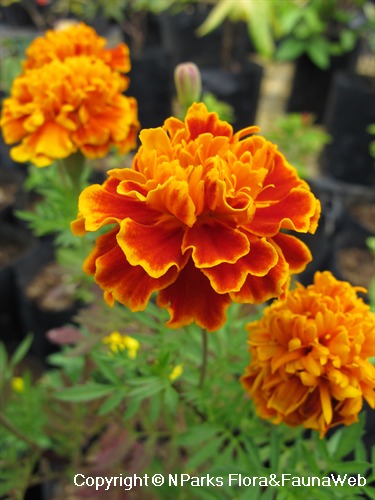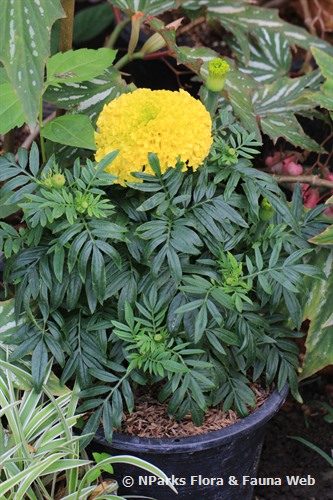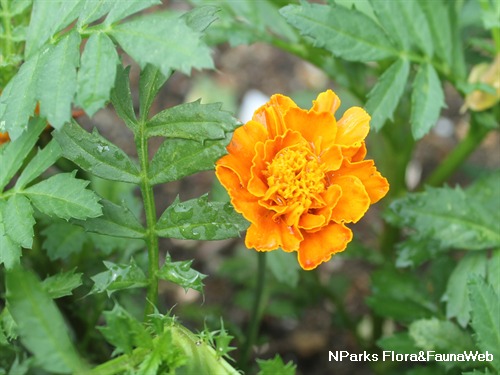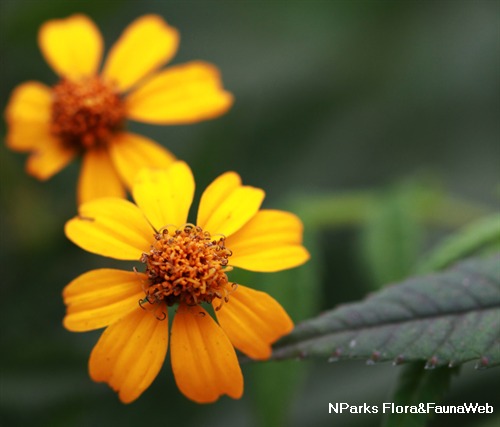
Back
Tagetes lucida Cav.
| Family Name: | Asteraceae (Compositae) |
| Synonyms: | Tagetes florida |
| Common Name: | Sweetscented Marigold, Sweet-scent Marigold, Sweet-scent Mexican Marigold, Mexican Mint Marigold, Spanish Tarragon, Winter Tarragon, Mexican Tarragon, Texas Tarragon, Sweet Mace |
Name
Classifications and Characteristics
| Plant Division | Angiosperms (Flowering Seed Plants) (Dicotyledon) |
|---|---|
| Plant Growth Form | Shrub |
| Lifespan (in Singapore) | Perennial |
| Mode of Nutrition | Autotrophic |
| Maximum Height | 0.4 m to 1.1 m |
| Maximum Plant Spread / Crown Width | 0.8 m |
Biogeography
| Native Distribution | Central America, Mexico |
|---|---|
| Preferred Climate Zone | Sub-Tropical / Monsoonal |
Description and Ethnobotany
| Growth Form | It is a perennial, semi-woody shrub which can grow to about 40 - 70 cm tall, sometimes up to 80 cm tall . |
|---|---|
| Foliage | Leaves are green, glabrous (hairless) and linear to lanceolate (4 - 9 cm in length, <1 cm wide). Leaves are sessile (leaf blade directly attached to the stem without a petiole). Leaf margin of older leaves is serrulate (finely toothed) near the middle to tip of leaves. |
| Flowers | Flowers small and orange-yellow (1.5 cm in diameter). Flowers are composite, having both disk flowers on the inside and ray flowers with petal-like structures on the outside. |
| Fruit | Fruits are classified as cypselae and each contains one seed. The fruits are linear and thin. On one end of the fruit, there is a two-pronged, beige projection known as a pappus that promotes seed dispersal. The fruit including the pappus is about 1 cm long. However, plants grown in Singapore typically do not produce fruits. |
| Habitat | Occurs in forests and on hilly or rocky slopes. |
| Cultivation | Plant in well-drained soil and space individuals 0.3 m apart. Usually a hardy plant that is resistant to most pests and disease. However, the plant may become susceptible to mealy bugs, snails, leaf miners, leaf spot, whiteflies, spider mites, leaf spot caused by bacterial pathogens, powdery mildew, damping off and botrytis. Prune back when the plant gets 'leggy' and allow it to grow back into a bushy form. |
| Etymology | The genus name “Tagetes” is derived from the Roman god Tages who was the son or grandson of Jupiter. The species epithet “lucida” is the Latin word for bright or shining and refers to the bright color of the flowers. |
| Ethnobotanical Uses | Edible Plant Parts : Edible Flowers Food (Herb or Spice): The leaves have a similar, but stronger flavor to French Tarragon. In the lowland tropics (like Singapore), it is easier to grow than French Tarragon. The flavor has also been described as being similar to licorice or anise. Flowers may be consumed raw in salads. The leaves may be added to fish or egg dishes. In Latin America, a popular tea is brewed from its leaves and flowers. (Fruit or Vegetable) Medicinal: Guadarrama-Cruz et al (2008) showed that extracts of aboveground parts had anti-depressant activity in rats, based on their increased effort to survive during a Forced Swimming Test. These extracts also contain coumarins with anti-bacterial or anti-fungal activity (Céspedes et al 2006). Another study also found that extracts have anti-bacterial activity, but attributed that activity to a flavone (Hernández et al 2006). Tea made from fresh leaves is used to cure various types of abdominal pain. Agriculture - Forestry: Extracts inhibit the growth of Colletotrichum gloeosporioides, a fungal pathogen that causes anthracnose (a disease that decreases fruit yield and quality). Cultural / Religious: In Mexico, Indians burn the dried leaves as incense in private and public religious ceremonies. Others: Caution: Smoking the leaves results in hallucinations. |
Landscaping Features
| Landscaping | Plant in herb gardens. Use as edging or along the border of flower gardens. |
|---|---|
| Desirable Plant Features | Fragrant (Foliage) |
| Landscape Uses | Flowerbed / Border, Container Planting |
| Thematic Landscaping | Golden Garden, Economic Garden |
Fauna, Pollination and Dispersal
| Seed or Spore Dispersal | Abiotic |
|---|
Plant Care and Propagation
| Light Preference | Full Sun, Semi-Shade |
|---|---|
| Water Preference | Moderate Water |
| Plant Growth Rate | Moderate |
| Rootzone Tolerance | Well-Drained Soils |
| Maintenance Requirements | Moderate |
| Pest(s) | Chewing Insects, Sucking Insects |
| Propagation Method | Seed, Stem Cutting, Division, Air-Layering |
Foliar
| Foliage Retention | Evergreen |
|---|---|
| Mature Foliage Colour(s) | Green |
| Mature Foliage Texture(s) | Smooth |
| Foliar Type | Simple / Unifoliate |
| Foliar Arrangement Along Stem | Opposite |
| Foliar Attachment to Stem | Sessile |
| Foliar Shape(s) | Non-Palm Foliage (Lanceolate, Linear) |
| Foliar Venation | Pinnate / Net |
| Foliar Margin | Entire, Serrate / Toothed, Serrulate |
| Foliar Apex - Tip | Acute |
| Foliar Base | Truncate / Square |
| Typical Foliar Area | Microphyll ( 2.25cm2 - 20.25 cm2 ) |
Non - Foliar and Storage
| Stem Type & Modification | Herbaceous |
|---|---|
| Root Type | Underground (Tap Root) |
Floral (Angiosperm)
| Flower & Plant Sexuality | Bisexual Flowers |
| Flower Colour(s) | Orange, Yellow / Golden |
|---|---|
| Flower Grouping | Cluster / Inflorescence |
| Flower Symmetry | Radial |
| Individual Flower Shape | Saucer-shaped |
| Flower Size - Remarks | 1.5 cm wide |
| Inflorescence Type | Head / Capitulum |
| Flowering Period | Free-Flowering |
| Flowering Habit | Polycarpic |
Fruit, Seed and Spore
| Mature Fruit Colour(s) | Black, Brown |
|---|---|
| Fruit Classification | Simple Fruit |
| Fruit Type | Indehiscent Dry Fruit , Cypsela |
Image Repository
Others
| Master ID | 29778 |
|---|---|
| Species ID | 4087 |
| Flora Disclaimer | The information in this website has been compiled from reliable sources, such as reference works on medicinal plants. It is not a substitute for medical advice or treatment and NParks does not purport to provide any medical advice. Readers should always consult his/her physician before using or consuming a plant for medicinal purposes. |












